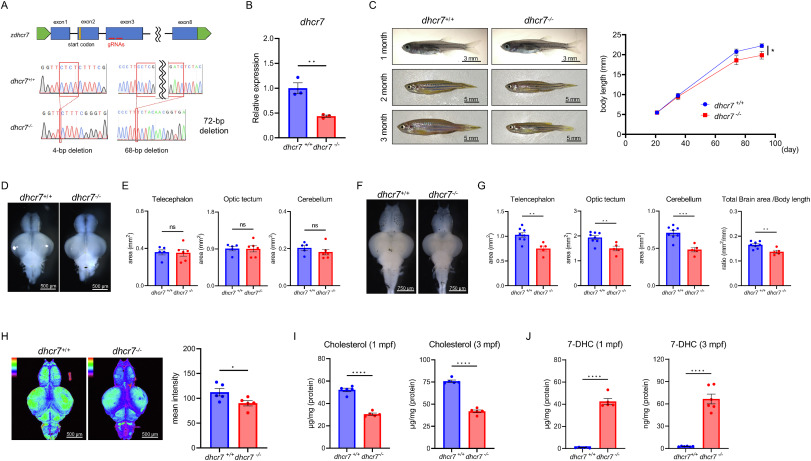Fig. 1 dhcr7−/− zebrafish show retarded growth, microcephaly, and changes in brain sterols (A) Schematic diagram for generating dhcr7−/− zebrafish using CRISPR/Cas9. (B) Relative mRNA expression of dhcr7 at 9 days post-fertilization in dhcr7+/+ and dhcr7−/− zebrafish larvae (n = 3, 6 larvae/sample). (C) Representative images and time course of body length in dhcr7+/+ (n = 12) and dhcr7−/− (n = 13) zebrafish. (D) Representative images of 1-month post-fertilization (mpf) dhcr7+/+ and dhcr7−/− zebrafish brains. (E) Measurement of the brain area in 1-mpf dhcr7+/+ (n = 5) and dhcr7−/− (n = 6) zebrafish. (F) Images of 3-mpf dhcr7+/+ and dhcr7−/− zebrafish brains. (G) Measurement of the brain area in 3-mpf dhcr7+/+ (n = 8) and dhcr7−/− (n = 5) zebrafish. The brain area adjusted for body length was calculated to assess microcephaly. (H) Heatmap images of filipin staining in 1-mpf dhcr7+/+ and dhcr7−/− zebrafish brains (n = 5 each). (I) Brain cholesterol in 1-mpf and 3-mpf dhcr7+/+ and dhcr7−/− zebrafish (n = 5 each). (J) Brain 7-DHC in 1-mpf (n = 5 each) and 3-mpf (n = 6 each) dhcr7+/+ and dhcr7−/− zebrafish. All values are presented as the mean ± SEM. *p < 0.05, **p < 0.01, ***p < 0.001, ****p < 0.0001. n.s: not significant. Microcephaly is the primary phenotype observed in patients with SLOS. No significant difference was found in the brain size of dhcr7−/− zebrafish at 1-mpf (Fig. 1D and E). However, differences in brain size in dhcr7−/− zebrafish became more pronounced as they grew. Their brains were significantly smaller than wild-type brains at 3-mpf (Fig. 1F and G). The levels of cholesterol and 7-DHC were assessed, and whole-mount filipin staining was performed on juvenile brains at 1-mpf. Cholesterol levels decreased significantly in dhcr7−/− zebrafish (Fig. 1H). We confirmed the decreased cholesterol in dhcr7−/− zebrafish brains using gas chromatography–mass spectrometry (GC–MS) in 1-mpf juvenile and 3-mpf adult zebrafish (Fig. 1I). In contrast, 7-DHC levels measured using liquid chromatography–mass spectrometry (LC–MS) were increased in dhcr7−/− zebrafish brains (Fig. 1J). These data are consistent with patients with SLOS, suggesting that dhcr7−/− zebrafish mimic the biochemical phenotype of human patients with SLOS. 3.2. Abnormalities in gfap+ neural stem cells in dhcr7−/− zebrafish We labeled mature neurons by mating dhcr7−/− zebrafish with huc promoter-driven Kaede fluorescent protein transgenic zebrafish [18]. The dorsal-view fluorescence intensity of mature neurons was significantly decreased in the telencephalon, optic tectum, and cerebellum of dhcr7−/− juvenile at 1-mpf, suggesting a decreased neuron density (Fig. 2A).
Image
Figure Caption
Figure Data
Acknowledgments
This image is the copyrighted work of the attributed author or publisher, and
ZFIN has permission only to display this image to its users.
Additional permissions should be obtained from the applicable author or publisher of the image.
Full text @ Biochem. Biophys. Res. Commun.

